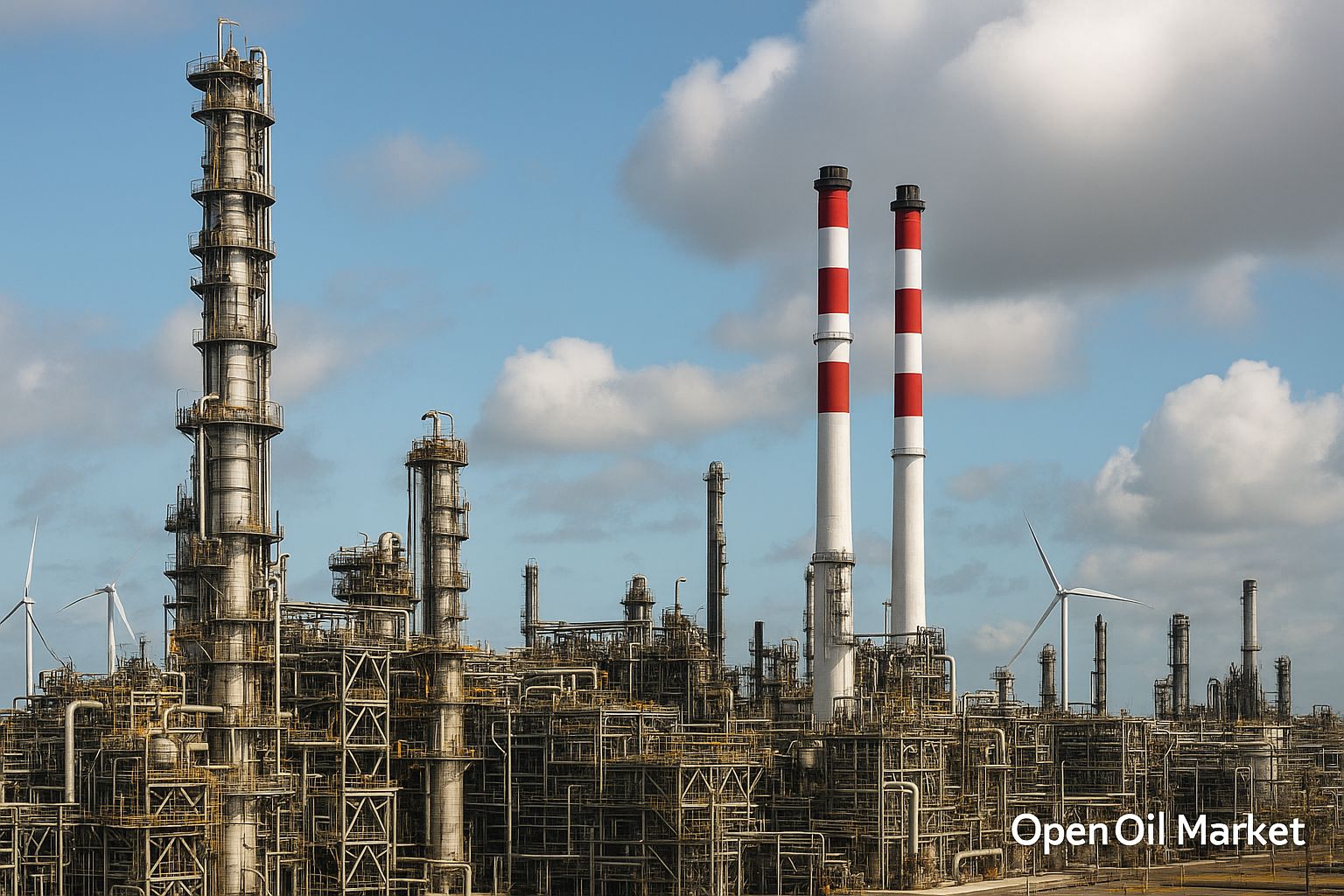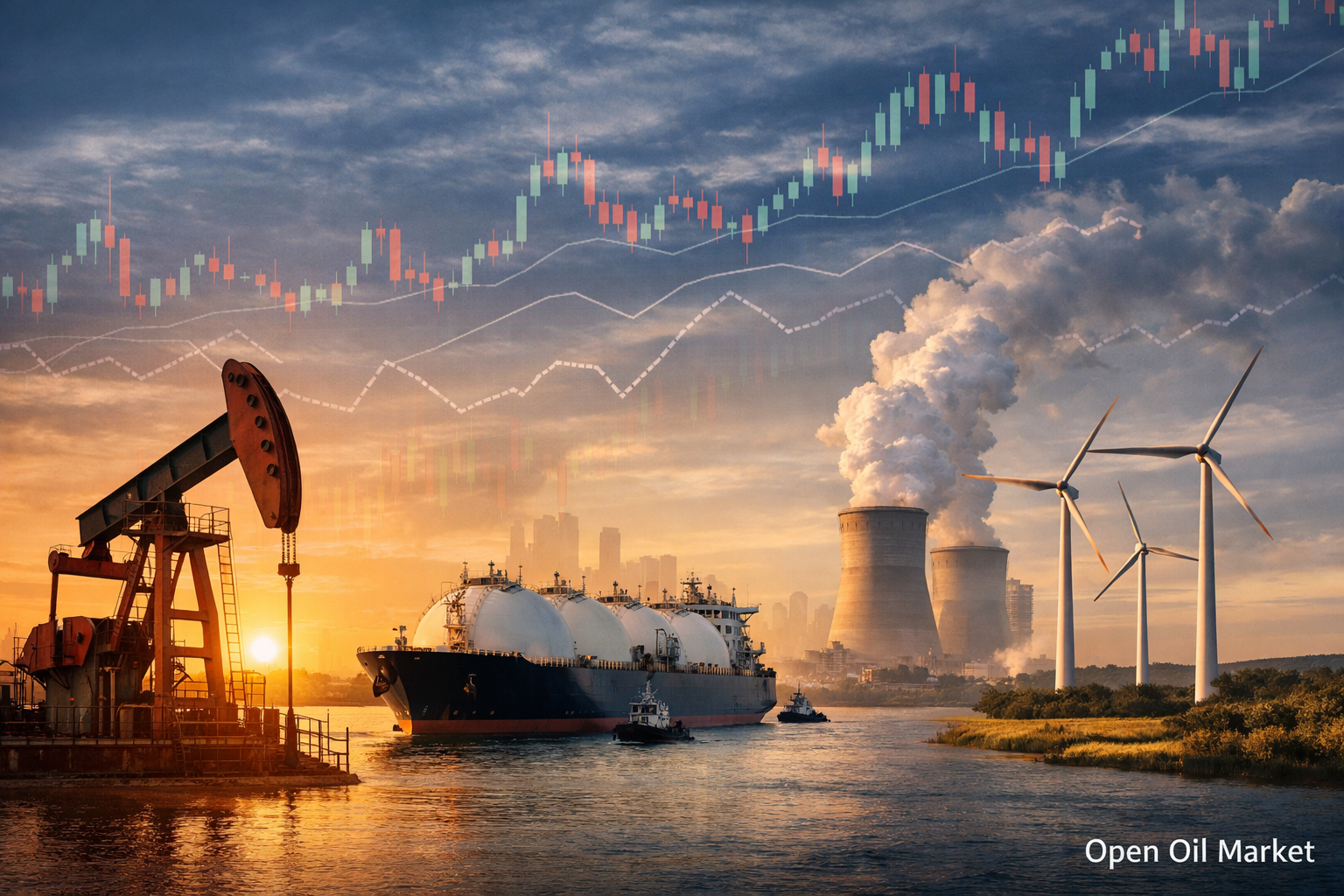
Main News of the Energy Sector as of November 8, 2025: Stringent Sanction Pressure, Stable Oil Prices, Record Gas Stocks, New Renewable Energy Records, High Coal Demand in Asia, and Continuing Fuel Price Stabilization Measures in Russia.
Current events in the fuel and energy complex (FEC) as of this date showcase a combination of heightened geopolitical tension and relative stability in raw material markets. Despite sporadic contacts between Russia and the West, there has been no significant easing of hostilities — on the contrary, new sanctions have been implemented, increasing risks for the energy sector. At the same time, global oil prices remain moderately stable, trading around mid-$60 per barrel, thanks to coordinated actions by OPEC+ and slowing demand. The European gas market is confidently entering the winter period, with underground gas storage (UGS) facilities in the EU filled to record levels, providing a cushion before winter and keeping exchange prices at relatively low levels. Simultaneously, the global energy transition is gaining new momentum — various countries are reporting record electricity generation from renewable sources, although for the reliability of energy systems, governments are not yet abandoning traditional resources. In Russia, after a summer spike in prices, authorities are continuing a comprehensive set of measures to stabilize the domestic fuel market, gradually normalizing the situation. Below is a detailed overview of key news and trends in the oil, gas, energy, and raw material sectors as of the current date.
Oil Market: OPEC+ Pauses Production Increases, Over-Supply Holds Prices Back
Global oil prices at the beginning of November are maintaining relative stability. The benchmark Brent crude is trading around $64–66 per barrel, while the American WTI is in the $60–62 range. Current quotes are approximately 10–12% lower than year-ago levels, reflecting a gradual normalization of the market after the price spikes of previous years. Price dynamics are influenced by a combination of factors, including:
- OPEC+ Actions. The oil alliance confirmed in early November a planned increase in production quotas by a symbolic 137,000 barrels per day in December, after which it signaled its intention to pause further increases in supply during the first quarter of 2026. This cautious approach aims to prevent market oversupply and support prices at acceptable levels while OPEC+ participants fight to maintain market share.
- Weak Demand Growth. Global oil consumption is increasing at slow rates. According to the International Energy Agency (IEA), the demand growth in 2025 will be less than 1 million barrels per day (compared to approximately 2.5 million barrels per day in 2023). OPEC also forecasts modest growth of around 1.2 million barrels per day. Economic slowdowns, especially in Europe and China, along with the effects of high prices in previous years (which stimulated energy conservation), are limiting appetite for oil.
- Increasing Stocks and Supply Outside OPEC+. Commercial oil stocks in the US and other countries have risen in the fall, signaling an oversupply situation in the market. Moreover, some producers outside OPEC+ are ramping up exports. For instance, Saudi Arabia sharply increased its external oil supplies with the end of the hot domestic demand season, while production in the US approached record levels. These factors exert additional pressure on global prices.
- Financial and Monetary Conditions. The strengthening of the US dollar to a multi-month high makes commodities more expensive for buyers with other currencies, restraining demand. Concurrently, central banks in developed countries are maintaining a restrained monetary policy, cooling business activity and fuel consumption.
Collectively, these conditions keep oil prices within a set corridor, benefiting commodity importers but presenting new challenges for oil-producing countries. Market participants are closely monitoring further steps from OPEC+: if circumstances change, the alliance may reconsider its production plans. For now, the outlook for the coming months remains cautiously optimistic: in the absence of shocks, prices are likely to remain around current levels.
Gas Market: Europe Welcomes Winter with Record Stocks and Stable Prices
The global gas market is primarily focused on Europe’s readiness for the winter period. Underground gas storage (UGS) in EU countries are over 95% full as of early November — a record figure exceeding the target level set by regulators. This safety margin, coupled with a steady influx of liquefied natural gas (LNG), keeps wholesale gas prices in Europe at relatively low levels, nearly half of what they were a year ago and significantly lower than the peaks of 2022. A key factor has been the weakened competition from Asian buyers: high stocks in China and other Asian countries have led to reduced LNG demand in the region, allowing additional volumes to be redirected to Europe.
As a result, the European market enters winter without the usual nervousness of recent years. Even planned downtime for local production and maintenance at Norwegian fields in the fall were compensated by increased imports. With the introduction of new terminals and the signing of long-term contracts for LNG supplies, the European Union has considerably reduced its reliance on pipeline gas from Russia, bringing its share in imports down to just a few percentage points. Analysts note that under normal weather conditions this winter, gas supply will remain adequate, and prices will be moderate. However, maintaining this balance will depend on a range of factors, including possible temperature anomalies during winter months and the timeline for launching new global LNG projects. By 2026, significant gas export capacity is expected to come online (primarily in the US and Canada), which could create a global surplus and additional pressure on prices.
International Politics: Sanction Confrontation Intensifies and Creates New Risks for Energy
The geopolitical environment around energy markets has escalated again in recent weeks. After unsuccessful attempts to foster dialogue over the summer, the West has turned to tightening sanction pressure on Russia. At the end of October, the United States imposed new sanctions against major Russian oil companies — Rosneft and Lukoil. These measures are aimed at limiting oil trade from the RF, and Indian and Chinese processors have been given time until November 21 to cease operations with sanctioned counterparties. Essentially, Washington has signaled its readiness to tighten secondary sanctions, forcing key importers of Russian oil to reconsider their cooperation with Moscow. Simultaneously, EU countries and the G7 continue to coordinate their sanctions policy. Although the next package of restrictions is being discussed longer than expected due to the need for consensus, the focus remains on curbing circumvention schemes and strengthening control over compliance with established price caps on oil and petroleum products.
The sanctions confrontation maintains uncertainty for the market: investments in Russian projects carry heightened risks, and the redirection of raw material flows is not without its complexities. Nevertheless, global oil supply remains sufficient due to redirected Russian exports to Asia and increased shipments from other players. Experts note that energy markets have learned to adapt to the realities of sanctions: for example, a "shadow fleet" of tankers for transporting Russian oil outside Western insurers has formed. However, new restrictions have the potential to cause localized disruptions — from reductions in investment in extraction to local logistical challenges. An additional factor of instability remains the military conflict: ongoing hostilities and occasional attacks (including on pipelines or refineries) can impact supply routes. Overall, geopolitics remains a critical uncertain parameter for energy resource markets, requiring companies and investors to pay heightened attention to possible sharp changes in trade conditions.
Asia: India Reduces Russian Oil Imports While China Strengthens Energy Security
Asian countries, primarily India and China, continue to play a key role in global energy markets, although their strategies are evolving in response to external factors. India was recently the largest buyer of Russian oil, actively taking advantage of discounts on crude. However, under pressure from Washington, Indian companies are prepared to significantly cut purchases of oil from Russia. In response to US sanctions against Rosneft and Lukoil, Indian refiners are reassessing their contracts: the largest corporation, Reliance Industries, reportedly plans to halt imports under a long-term agreement with Rosneft, while state-owned refineries are ensuring that no shipments come directly from companies that have been sanctioned starting in November. This means that the volume of Russian supplies to India (averaging over 1.7 million barrels per day from January to September) will begin to decline. New Delhi aims to replace falling volumes with Middle Eastern and African varieties; although such a restructuring may increase import costs (analysts estimate a potential rise in India's oil bill of about 2%), it will help avoid trade tariffs and maintain access for Indian products to the US market. Simultaneously, India is accelerating diversification: increasing domestic refining capacities and LNG imports, thus strengthening energy security.
On the contrary, China continues to maintain high levels of purchases of Russian energy resources, capitalizing on the situation. After the departure of European clients, Beijing became the main buyer of Russian oil and gas, ensuring stable demand. Reports indicate that Russian oil exports to China continue to grow: for example, agreements between Rosneft and CNPC have allowed for an increase in oil transit through Kazakhstan by approximately 2.5 million tons per year. Chinese companies are also actively purchasing liquefied gas through long-term contracts, taking advantage of favorable prices. At the same time, China is striving to reduce import dependence: resource development within the country is ongoing, and the country leads the world in the introduction of new solar and wind energy capacities. In the first half of 2025, electricity generation from renewable sources in China grew so much that coal consumption decreased by 2% compared to last year. Thus, India and China are responding differently to external challenges: India is forced to reduce cooperation with Russia to maintain relations with the West, while China deepens its energy partnership with Russia while simultaneously investing in its own extraction and "green" energy.
Energy Transition: Record Growth of Renewable Energy and Early Signs of Declining Coal Generation Share
The global shift to clean energy in 2025 is showcasing new achievements. According to analysts, total electricity generation from renewable sources (solar and wind) has surpassed that from coal-fired power plants for the first time. In the first half of the year, global solar generation rose by approximately 30% compared to the same period in 2024, while wind generation increased by 7–8%, covering the lion's share of increased demand for electricity. This marks a historic moment: clean energy has begun to curb the growth of fossil fuel usage. The main contribution to the rapid development of renewable energy sources came from China and India, which are swiftly ramping up capacities. For comparison, in Europe and the US, renewable generation is also continuing to grow, but weather fluctuations (unusually weak winds, droughts) have temporarily led to increased reliance on gas and coal generators. Nevertheless, the International Energy Agency forecasts that global renewable energy capacities will double by the end of the decade, with about 80% of new capacity expected to come from solar panels.
Despite the records in "green" energy, traditional methods of energy generation remain significant. To ensure 24/7 uninterrupted electricity supply, countries continue to use gas, coal, and nuclear power plants as balancing capacities. Simultaneously, energy storage infrastructure (battery systems, pumped storage stations) continues to develop, but their scale is currently insufficient to fully replace traditional generation during peak hours. For investors, this means that while decarbonization is gaining traction, the oil and gas and coal sectors will retain their roles in the foreseeable future, providing base load and energy security. At the same time, the increasing demand for equipment for renewable energy sources and electricity grid infrastructure creates new market opportunities, stimulating capital inflow into the renewable energy sector.
Coal: Asian Demand Keeps the Global Market at Historically High Levels
Despite the climate agenda, the global coal market in 2025 remains extremely robust. Global coal consumption has approached record levels, only slightly below the peak of 2022. The primary drivers of demand are Asian countries. China and India continue to derive a significant portion of their electricity from coal generation, providing the base load for their energy systems. Although the growth rates of coal consumption in these countries have slowed due to the development of renewable energy sources (in China and India, the growth of coal-fired power generation has been gradually decelerating), their demand in absolute terms remains enormous. Additionally, developing economies in Southeast Asia (Indonesia, Vietnam, etc.) continue to construct new coal-fired power plants to meet growing energy needs.
As a result, global coal production remains high. Major exporters — such as Indonesia, Australia, and Russia — are ramping up production to supply Asian markets, compensating for reduced demand in Europe and North America. Prices for thermal coal have significantly decreased over the past year compared to peak values during the 2022 crisis, yet they remain attractive for producers. Many mining companies are reporting high profits, prompting investment in maintaining or even expanding production capacities. At the same time, international pressure in the fight against climate change is intensifying: financial institutions are increasingly refusing to finance new coal projects, expecting that global demand will plateau in the coming years. Thus, the coal industry currently balances between short-term growth driven by Asian demand and long-term challenges of transitioning to a low-carbon economy.
Russian Oil Product Market: Stabilization Measures and Initial Results
In the internal fuel segment of Russia, after the summer price crisis, the situation is gradually coming under control thanks to emergency measures taken by the government. In August, wholesale prices for gasoline and diesel reached historic highs (exchange prices for AI-95 gasoline exceeded 80,000 rubles per ton), leading to localized shortages in several regions. The causes of the surge included a combination of factors: seasonal increases in fuel consumption, reduced payments under the damping mechanism, a series of unplanned shutdowns at refineries (including due to drone attacks), and profit from exports that prompted companies to cut supplies to the domestic market. In response, authorities imposed restrictions on oil product exports: for vertically integrated companies, the ban on the export of gasoline and diesel fuel lasted until the end of September, while for independent producers and traders, it extended to the end of October. Oil companies are mandated to prioritize domestic consumers, and repair schedules at major refineries have been adjusted to avoid downtime during peak demand periods. Additionally, fuel supplies to problematic regions (e.g., the Far East and Crimea) have been increased to smooth out imbalances.
By the beginning of November, the measures being implemented began to yield results. Wholesale prices have retreated from peak levels: compared to mid-August, gasoline prices have decreased by approximately 8%, and diesel fuel by 5–6%. Retail prices have stabilized; according to Rosstat, the increase in prices at gas stations since the beginning of the year is about 8%, which, although above inflation, has not been rising in recent weeks. The government claims that the situation is normalizing, and there is no fuel shortage at gas stations. Meanwhile, a decision has been made to adjust the parameters of the damping mechanism — expanding the price deviation limits at which refiners receive compensation. This step will allow refineries to receive payments even with higher domestic prices, reducing the incentive to redirect products to export. Commentary: “Regulators are essentially forced to accommodate oil companies, otherwise the industry will not be able to reliably supply the fuel market. Increasing the damping threshold is justified, although it carries risks of accelerating inflation, but it is necessary under current conditions. This decision will make price increases more predictable and prevent acute fuel shortages,” industry experts note.
It is expected that with continued government control, fuel price growth in the second half of the year will be kept within acceptable limits. Export restrictions will be eased gradually — only after the domestic market is fully saturated and reserves are created. Authorities also allow for the introduction of protective tariffs on the export of oil products in the future if necessary to contain prices domestically. Thus, energy management aims to balance support for refiners with consumer interests, gradually bringing the fuel market out of a stressful state.




